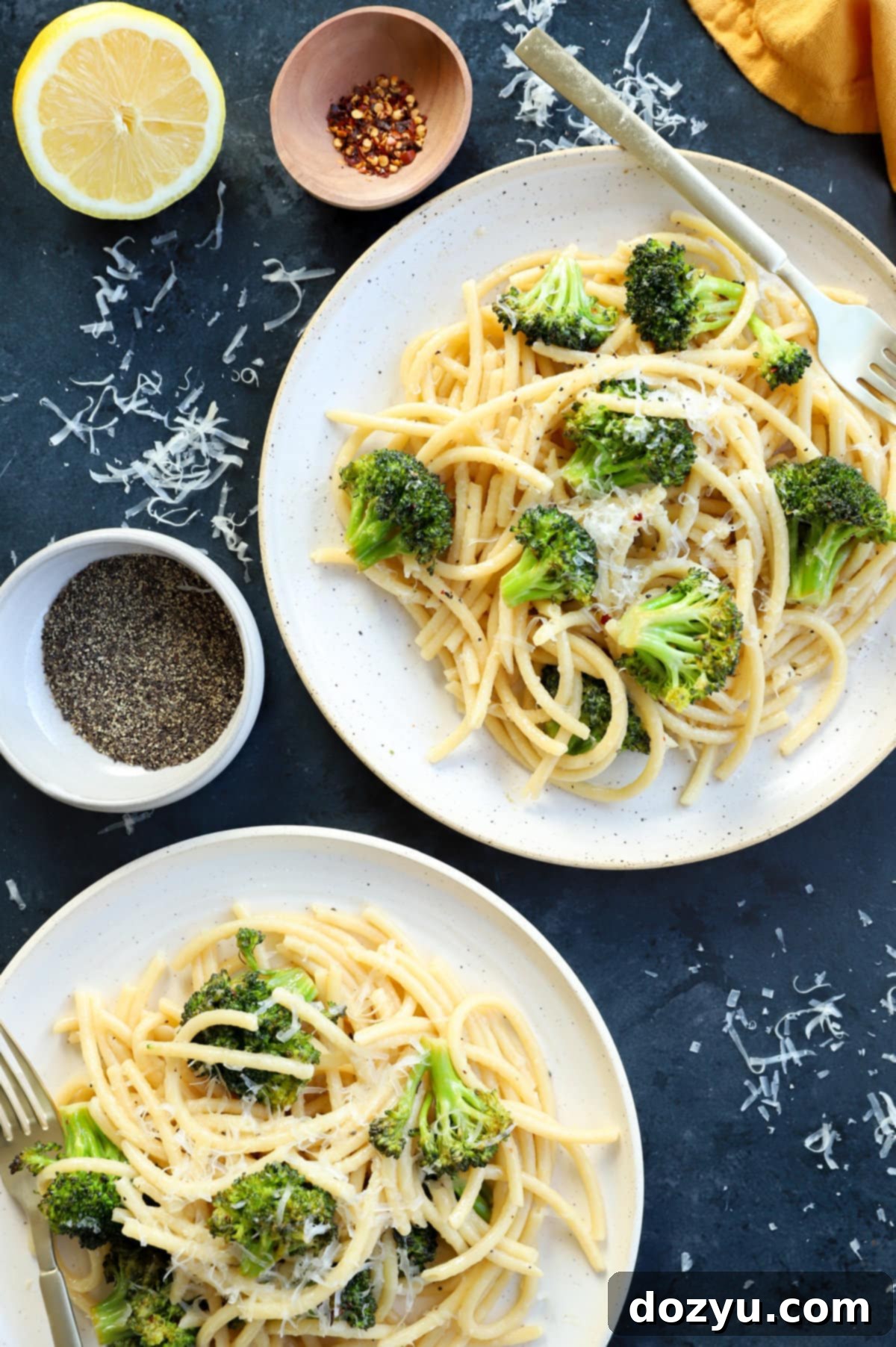Mastering Bucatini Cacio e Pepe with Roasted Broccoli: A Creamy & Flavorful Weeknight Pasta
Bucatini Cacio e Pepe with Roasted Broccoli reimagines the classic Roman “cheese and pepper” pasta by adding a vibrant, healthy twist. This minimalist dish, celebrated for its simple yet profound flavors, becomes an even more delightful experience with the inclusion of tender-crisp broccoli florets. The creamy, peppery, and rich sauce, crafted from just a few humble ingredients, promises an absolutely out-of-this-world taste. It’s a quick-to-prepare and effortlessly delicious dinner that will undoubtedly become a staple in your home!
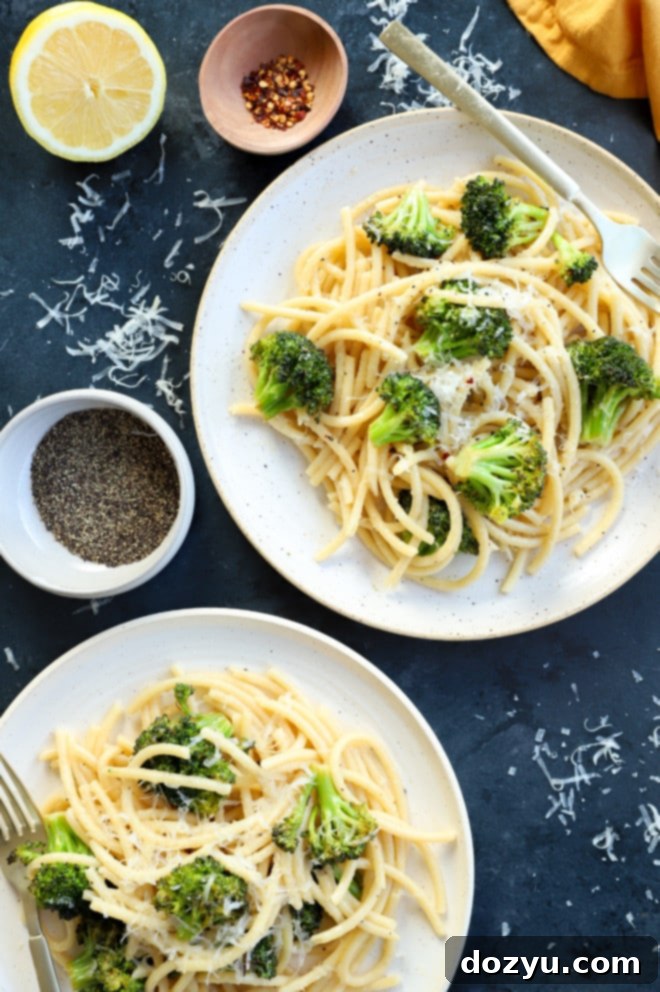
table of contents
Toggle
About This Bucatini Cacio e Pepe with Broccoli
I distinctly recall my inaugural attempt at making cacio e pepe. It was strikingly similar to my first foray into carbonara – an unmitigated disaster. In my eagerness, I neglected the crucial recipe notes and simply dumped all the cheese in, fully expecting a perfectly glossy, emulsified sauce to magically appear. Naturally, that’s not how this delicate dish works. The result was a clumpy, disheartening mess that put me off attempting it again for years.
However, after being inspired by countless photos from friends’ trips to Italy, I felt compelled to conquer this Roman classic. As it turns out, cacio e pepe isn’t inherently difficult; it simply demands a bit of patience and adherence to the instructions (a novel concept, perhaps!). This particular bucatini cacio e pepe recipe offers a delightful twist on the traditional preparation. By incorporating roasted broccoli tossed with fresh lemon juice and a touch of red pepper flakes, we introduce an extra layer of brightness, a subtle tang, and a gentle warmth that beautifully complements the rich, peppery, and cheesy pasta. The broccoli not only adds a wonderful textural contrast but also a welcome boost of nutrients, seamlessly integrating vegetables into your meal rather than serving them as an afterthought. While I personally love the added depth and nutrition, feel free to omit the broccoli if you prefer a strictly classic rendition of cacio e pepe!
What is Bucatini Cacio e Pepe?
Originating from Rome, one of Italy’s most historic and culinary-rich cities, Cacio e Pepe literally translates to “cheese and pepper,” perfectly encapsulating the minimalist essence of this beloved pasta dish. At its core, this recipe celebrates the power of simple, high-quality ingredients to create an extraordinary flavor experience. Traditionally, it features Pecorino Romano cheese, a sharp, salty sheep’s milk cheese, alongside freshly cracked black pepper and the starchy water from cooking the pasta. Some variations also incorporate Parmesan cheese for a slightly milder, nuttier profile.
The beauty of this Roman staple lies in its ability to transform basic components into a luxuriously creamy, deeply savory, and intensely peppery sauce that coats every strand of pasta. The starch from the pasta water plays a vital role in emulsifying the grated cheese and pepper into a smooth, velvety consistency, creating a dish that is both comforting and sophisticated. When prepared correctly, it’s a testament to Italy’s “cucina povera” philosophy – humble ingredients elevated to culinary art. This dish is renowned for its addictive flavor profile, making it an instant favorite for anyone who appreciates the elegant simplicity of Italian cooking.
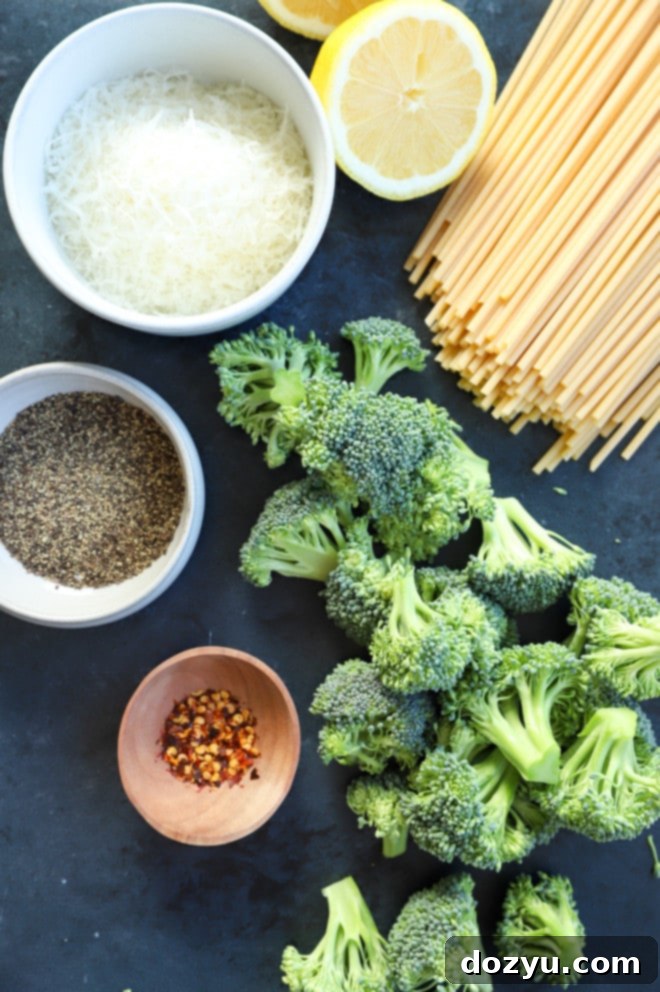
Ingredients for Perfect Cacio e Pepe
Creating an exceptional Bucatini Cacio e Pepe with Broccoli relies on a few high-quality, simple ingredients. Each component plays a crucial role in building the dish’s signature creamy, peppery, and rich flavor profile:
- Broccoli: Opt for fresh broccoli florets, ideally from one medium head. Fresh broccoli provides the best texture and vibrant green color when roasted. If using frozen broccoli, ensure it’s fully thawed and patted dry to prevent a watery outcome, and reduce the roasting time to about 5 minutes. The subtle earthy flavor and slight bitterness of the broccoli beautifully complement the rich cheese sauce.
- Olive Oil: Extra-virgin olive oil is essential for coating the broccoli, helping it crisp up beautifully in the oven and infusing it with a delicate, fruity flavor.
- Lemon Juice: Freshly squeezed lemon juice brightens the roasted broccoli and adds a crucial zesty counterpoint to the richness of the cheese and pepper. It provides an acidic “zing” that elevates the entire dish.
- Red Pepper Flakes: These are optional but highly recommended. A pinch or two of red pepper flakes introduces a subtle, building heat that harmonizes wonderfully with the black pepper and adds another layer of complexity to the flavor.
- Pasta: Bucatini is the star here! Its hollow center is perfect for capturing and holding the creamy cacio e pepe sauce, offering a delightful textural experience. If bucatini is unavailable or not to your preference, good quality spaghetti or even linguine can be an excellent substitute, providing a similar long, satisfying strand.
- Butter: Unsalted butter is preferred, as it gives you control over the overall saltiness of the dish. It contributes to the sauce’s creaminess and helps “bloom” the black pepper, intensifying its aroma and flavor. If only salted butter is on hand, simply reduce the amount of salt added to the pasta water.
- Black Pepper: This is arguably the most critical flavor component. Always use freshly cracked black pepper, not pre-ground, fine pepper. The coarse grind provides a much more robust, aromatic, and authentic peppery kick that is central to “cacio e pepe.” Blooming it in butter unleashes its full potential.
- Cheese: The choice between Parmesan cheese and Pecorino Romano cheese will subtly alter the dish’s character. Pecorino Romano is the traditional choice, offering a sharper, saltier, and more pungent flavor, being a sheep’s milk cheese aged for less time. Parmesan, made from cow’s milk and typically aged longer, is milder, nuttier, and slightly less salty. Both work beautifully, so choose the one that best suits your palate for a truly delicious Roman pasta. Remember to finely grate the cheese for optimal melting!
Essential Equipment for This Recipe
Having the right tools at hand makes preparing this Bucatini Cacio e Pepe with Broccoli a smooth and enjoyable process:
- Chef’s Knife and Cutting Board: Indispensable for breaking down the broccoli into uniform florets, ensuring even roasting. A good quality knife makes prep work quick and safe.
- Silicone Baking Mat or Parchment Paper: For lining a rimmed half-sheet baking pan, this prevents the broccoli from sticking and makes for easy cleanup after roasting.
- Large Stockpot: Essential for boiling the pasta in a generous amount of salted water, allowing the bucatini to cook evenly and develop the necessary starchy water for the sauce.
- Large Skillet or Sauté Pan: The hero of the dish! This is where the magic happens, where the pepper is bloomed, the pasta is tossed, and the creamy sauce is formed. A wide surface area helps the sauce come together efficiently.
- Tongs: A simple but invaluable tool for easily transferring pasta from the boiling pot to the skillet, and for tossing the pasta with the sauce, ensuring every strand is coated.
- Cheese Grater: A fine-grated cheese is absolutely crucial for preventing clumps and achieving a silky-smooth sauce. A microplane grater or the fine side of a box grater is ideal for this task.
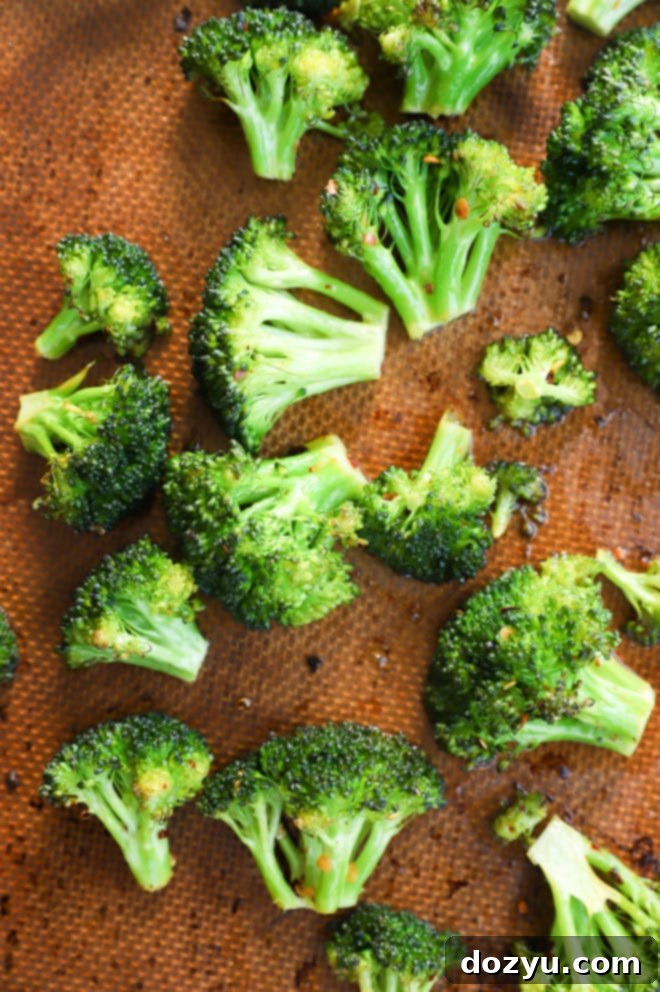
How to Make Bucatini Cacio e Pepe with Broccoli
This recipe comes together quickly, making it perfect for a weeknight. Follow these steps for a delicious and creamy pasta dish:
Roast the Broccoli to Perfection
Begin by preheating your oven to a high temperature, typically 450˚F, to ensure the broccoli gets nicely caramelized and tender-crisp. In a bowl, toss your fresh broccoli florets with a generous drizzle of extra virgin olive oil, a splash of fresh lemon juice, and a few pinches of red pepper flakes for a hint of heat. Season well with salt and freshly ground black pepper. Spread the seasoned broccoli in a single layer on a baking sheet lined with a silicone mat or parchment paper. Roast for approximately 10 minutes, or until the florets are tender with slightly browned edges. Once roasted, remove the broccoli from the oven and set it aside; it will be folded into the pasta at the very end.
Cook the Bucatini Al Dente
While the broccoli roasts, bring a large pot of heavily salted water to a rolling boil. Remember, the pasta water is a crucial ingredient in cacio e pepe, so make sure it’s seasoned like the sea. Add the bucatini pasta and cook until it is just al dente, meaning it still has a slight bite to it. This usually means cooking it a couple of minutes less than the time indicated on the package. It’s vital not to overcook the pasta, as it will continue to cook slightly when combined with the sauce. Before draining, make sure to reserve at least 1 to 1.5 cups of the starchy pasta water. The easiest way to do this is to simply remove the pasta from the pot using tongs or a spider, allowing the water to remain for later use.
Bloom the Pepper for Maximum Flavor
As the pasta cooks, prepare your pepper base. In a large skillet or sauté pan, melt the unsalted butter over medium heat. Once the butter is melted and slightly fragrant, add the freshly ground coarse black pepper. Cook the pepper gently for about 30 seconds, stirring constantly. This crucial step, known as “blooming” the pepper, allows its volatile oils to release, intensifying its aroma and flavor significantly. Do not let the pepper burn. After blooming, immediately turn off the heat. This prepares a fragrant foundation for your cacio e pepe sauce.
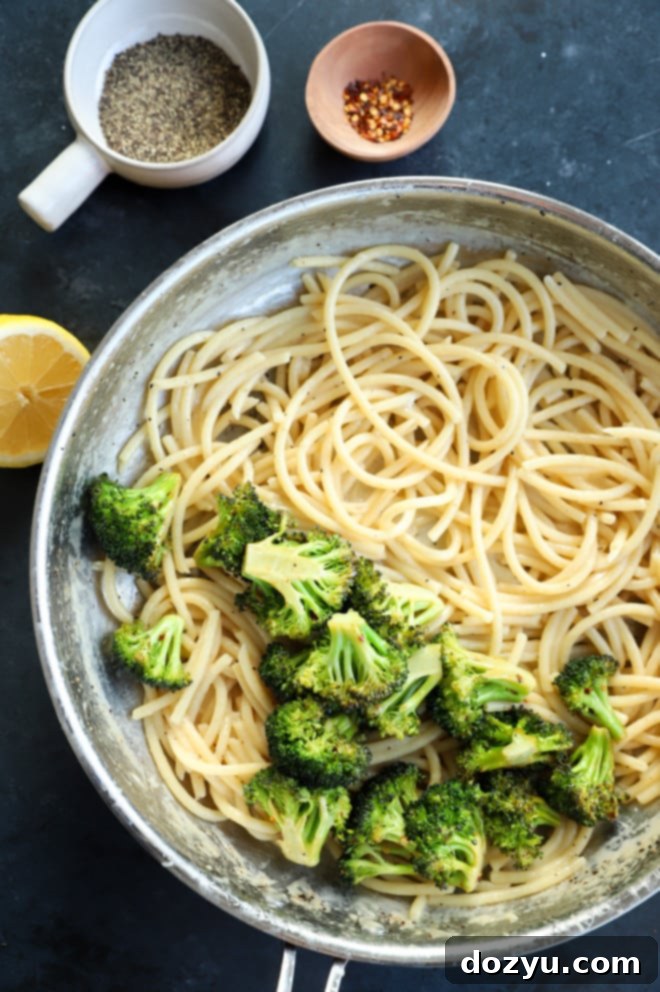
Finish the Sauce: The Creamy Magic
With the heat off (or very low), add the al dente bucatini directly to the skillet containing the melted butter and bloomed pepper. Immediately add about 1/3 cup of the reserved starchy pasta water to the pan. Begin to vigorously toss and stir the pasta, ensuring it’s well coated. This step is critical for developing the creamy sauce. Now, start adding the finely grated Pecorino Romano (or Parmesan) cheese in small increments – about a quarter of the total amount at a time. After each addition, vigorously toss the pasta for about 30 seconds to allow the cheese to melt and emulsify with the pasta water and butter, forming a smooth, glossy sauce. Wait for each batch of cheese to fully melt and incorporate before adding the next. This gradual addition, combined with continuous tossing, is the secret to preventing the cheese from clumping and achieving that desirable velvety texture. If the sauce appears too thick or dry at any point, add a tablespoon or two of additional pasta water as needed, continuing to toss until the perfect consistency is reached.
Once your rich, creamy, and glossy sauce has formed, gently fold in the roasted broccoli florets. Toss briefly to combine, allowing the broccoli to warm through and soak up some of the incredible sauce. Serve the Bucatini Cacio e Pepe with Broccoli immediately. For an extra flourish, I highly recommend garnishing each serving with a generous amount of freshly ground black pepper and a final sprinkle of freshly grated cheese. This dish is best enjoyed right away, so gather your loved ones and savor every peppery, cheesy bite!
Top Tips for a Flawless Cacio e Pepe
Achieving the perfect, creamy Cacio e Pepe, especially with the added broccoli, requires attention to a few key techniques. These tips will help you avoid common pitfalls and ensure a spectacular result every time:
- Bloom the Pepper: Do not skip the step of blooming the black pepper in melted butter or olive oil. This is fundamental to Cacio e Pepe. Gently cooking the pepper for a short period releases its essential oils, intensifying its aroma and flavor immensely. Always use freshly cracked, coarse black pepper for the best taste – pre-ground pepper simply won’t deliver the same vibrant, pungent notes.
- Salt Your Pasta Water Generously: This might sound obvious for pasta, but it’s even more crucial for Cacio e Pepe. The starchy pasta water is the backbone of your sauce, and its saltiness will directly flavor the entire dish. Think of it as seasoning the sauce from the inside out. Aim for water that tastes like the sea.
- Cook Pasta to Just Al Dente: Perfect pasta texture is non-negotiable. Cook your bucatini until it’s just al dente, meaning it still offers a firm bite. This is typically about 1-2 minutes less than the package instructions suggest. The pasta will continue to cook as it’s tossed with the hot sauce, ensuring it doesn’t become mushy and maintains its delightful chewiness.
- Finely Grate Your Cheese: This is a critical step for a smooth, clumpless sauce. Use a microplane or the finest side of a box grater. Finely grated cheese melts more quickly and evenly, allowing it to emulsify seamlessly with the starchy pasta water. Coarsely grated cheese is far more prone to clumping.
- Add Cheese Gradually and Continuously Toss: Patience is a virtue here! Never add all the cheese at once. Introduce it in small increments (about a quarter at a time), vigorously tossing the pasta after each addition. This gradual process, combined with the constant movement, allows the cheese to melt slowly and integrate into the starchy water, creating a stable, creamy emulsion.
- Master Pasta Water Control: The reserved pasta water is liquid gold. Its starch content is what thickens and binds the sauce. Start with the recommended amount (1/3 cup initially), but be prepared to add more in small splashes (tablespoon by tablespoon) if the sauce is too thick, or let it simmer briefly if it’s too runny. Learning to eyeball the right consistency with pasta water comes with practice, but it’s essential for a perfect Cacio e Pepe.
Craving more easy and delicious pasta recipes? Explore these favorites: Spicy Gochujang Noodles with Chicken and Greens | Bright & Creamy Lemon Ricotta Pasta | Lightning-Fast 15-Minute Singapore Street Noodles | Comforting Instant Pot White Cheddar Mac and Cheese
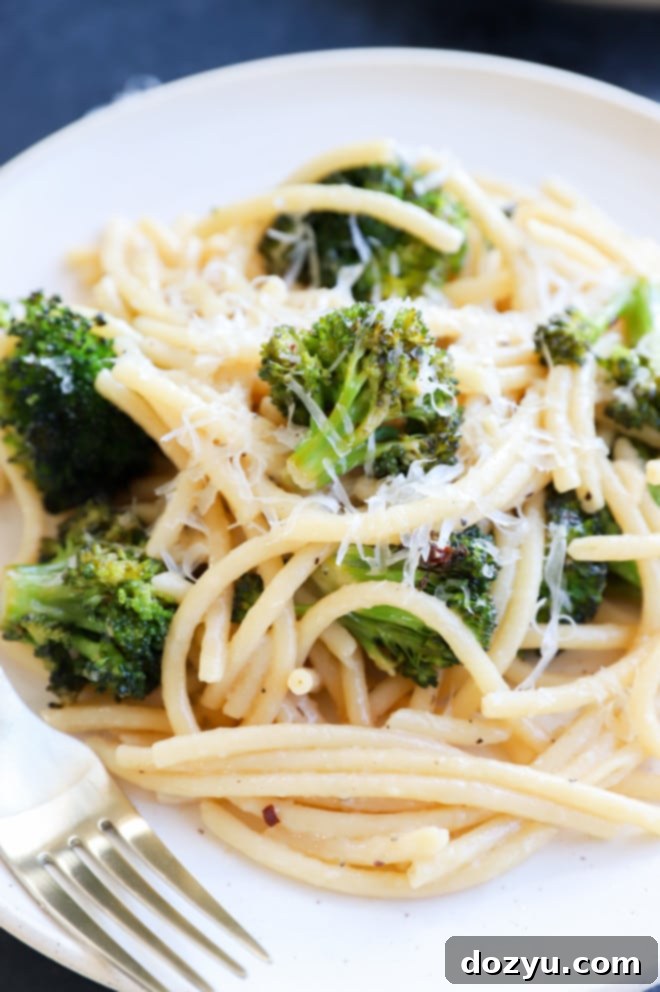
How to Prevent Cheese from Clumping
Preventing the cheese from clumping is often the biggest challenge when making Cacio e Pepe, and it’s a common stumbling block for many home cooks. Even experienced chefs can get it wrong if rushed! The key lies in understanding the science of emulsion and patiently executing the steps. Here’s how to ensure a silky-smooth cheese sauce every time:
- Slow Down and Be Patient: The most crucial advice is to take your time. Rushing leads to clumping.
- Use Freshly Grated, High-Quality Cheese: Pre-shredded cheeses often contain anti-caking agents that hinder smooth melting and emulsification. Always use a block of good quality Pecorino Romano or Parmesan and grate it yourself.
- Finely Grate the Cheese: This cannot be stressed enough. The finer the grate, the quicker and more evenly the cheese will melt. A microplane is your best friend here. Coarsely grated cheese takes too long to melt, increasing the likelihood of it seizing into clumps.
- Control the Temperature: The skillet should be off the heat or on very low heat when you begin adding the pasta and cheese. Too much heat will shock the cheese, causing the proteins to tighten and clump. The residual heat from the pasta and pasta water is usually sufficient to melt the cheese gently.
- Add Cheese in Small Increments: This is the golden rule. Never add all the cheese at once. Introduce it in small batches, about a quarter of the total amount at a time. This allows each portion to melt and integrate into the sauce before being overwhelmed by more cheese.
- Vigorously Toss and Stir Continuously: After each small addition of cheese and pasta water, immediately and vigorously toss the pasta with tongs. This constant motion helps the cheese melt into the starchy water and butter, creating a smooth, stable emulsion. The friction and agitation are essential for preventing the cheese from solidifying into clumps.
- Utilize Starchy Pasta Water Correctly: The starch in the reserved pasta water is vital for emulsifying the sauce. Ensure the water is hot when you add it. If your sauce is clumpy, adding another small splash of hot pasta water while continuously tossing can sometimes help loosen and smooth it out.
Can I Use a Different Type of Pasta?
While bucatini is my absolute favorite for Cacio e Pepe due to its unique texture and ability to cradle the creamy sauce within its hollow center, it’s understandable if it’s not always available or simply not your preference. The good news is that you can absolutely use a different type of pasta. The most recommended substitute is spaghetti, which offers a similar long, satisfying strand that still allows the rich sauce to cling beautifully. Other long pasta shapes like linguine or even fettuccine can also work. The key is to choose a pasta that has enough surface area for the sauce to adhere to and that cooks well to an al dente texture. Ultimately, the best pasta is the one you enjoy eating the most, so feel free to experiment with your favorite long-strand options!
Can I Make This Bucatini Pasta Ahead of Time?
This is purely my personal opinion, but Cacio e Pepe, in its truest form, is best enjoyed immediately after it’s prepared. The magic of its creamy, emulsified sauce and the perfect al dente pasta is at its peak when fresh. The sauce can start to tighten and the pasta can lose its ideal texture as it cools. However, life happens, and sometimes leftovers are inevitable or planning ahead is necessary. This recipe isn’t designed to yield a massive amount of leftovers, but if you do find yourself with extra, don’t despair!
To store any remaining Bucatini Cacio e Pepe, allow it to cool completely before transferring it to an airtight container. Keep it refrigerated for up to five days. While it won’t be quite the same as fresh, it can still be a delicious meal with proper reheating techniques. I’ll provide more detailed instructions on how to reheat the pasta correctly to best revive its creamy texture, ensuring you can still enjoy your flavorful leftovers.
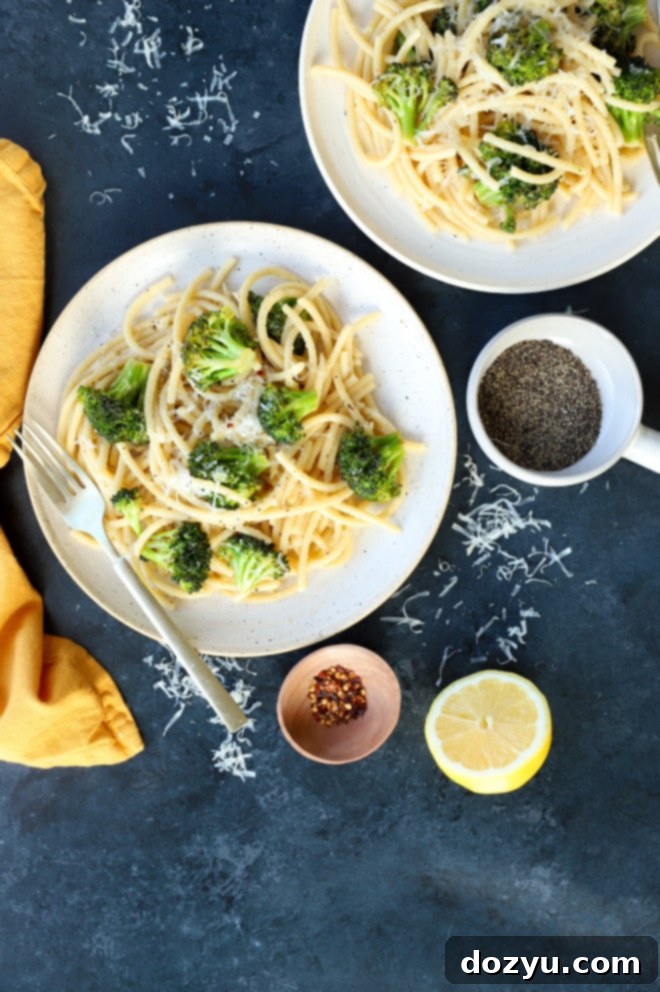
Pecorino Romano vs. Parmesan: Which Cheese is Best?
The choice between Pecorino Romano and Parmesan (Parmigiano-Reggiano) cheese is a common dilemma for Cacio e Pepe, and ultimately, you can use either to achieve a delicious result! Both are hard, aged Italian cheeses, but they offer distinct flavor profiles that will subtly change your dish.
- Pecorino Romano: This is the traditional cheese for authentic Roman Cacio e Pepe. Made from sheep’s milk, it’s typically aged for less time than Parmesan, resulting in a much sharper, saltier, and more pungent (some describe it as “tangy” or “funky”) flavor. Its robust character stands up beautifully to the intense black pepper. If you want the most authentic and bold Cacio e Pepe experience, Pecorino Romano is the way to go.
- Parmesan (Parmigiano-Reggiano): Made from cow’s milk and typically aged longer, Parmesan offers a milder, nuttier, and slightly sweeter flavor profile compared to Pecorino Romano. It’s still savory and complex but less assertive. Using Parmesan will yield a Cacio e Pepe that is perhaps a bit more approachable for those who find Pecorino Romano too strong.
My recommendation is to use whichever cheese you prefer to eat normally and that you can find as a high-quality, fresh block for grating. For the truest Roman flavor, Pecorino Romano is ideal, but Parmesan makes a wonderfully creamy and flavorful alternative. You can even use a combination of both if you want to balance the intensity!
Troubleshooting: My Pasta is Dry!
If your Bucatini Cacio e Pepe ends up looking dry and lacks that signature creamy gloss, don’t worry – this is a common issue with a simple fix! The dryness usually indicates that there isn’t enough liquid, specifically the starchy pasta water, to properly emulsify with the cheese and butter. The solution is to gradually add more of that precious reserved pasta water. Begin by adding a tablespoon or two of hot pasta water to the skillet with your pasta. Continuously toss and stir the pasta vigorously. The hot, starchy water will help to loosen the sauce and encourage the cheese to re-emulsify. You may need to repeat this process a couple of times, adding small splashes of water and tossing, until your sauce reaches the desired smooth and creamy consistency. Remember, it’s easier to add more liquid than to remove it, so go slow and steady.
Troubleshooting: My Pasta Sauce is Too Runny!
On the flip side, if your pasta is swimming in a sauce that’s too thin or watery, it means there’s too much liquid in relation to the cheese and starch. This can happen if too much pasta water was added initially or if the cheese didn’t emulsify properly. Here’s how to remedy a runny Cacio e Pepe sauce:
- Gently Simmer: Place the skillet back on very low heat. Gently simmer the pasta, tossing frequently, to allow some of the excess liquid to evaporate and the sauce to thicken naturally. Be careful not to cook it for too long, as the pasta can become overcooked.
- Add a Little More Cheese: If you have any finely grated cheese left, adding another small sprinkle (and tossing vigorously) can help absorb some excess moisture and thicken the sauce.
- Counter-intuitive Pasta Water Trick: This might sound paradoxical, but sometimes a small splash (half a tablespoon) of *more* hot, starchy pasta water can actually help. When added to a simmering sauce and vigorously tossed, the additional starch can sometimes “kickstart” the emulsion, helping the sauce to bind and thicken more effectively as it continues to simmer. This works by increasing the starch content, which is key to thickening. Only try this if simmering alone isn’t quite doing the trick and you’ve already tried adding more cheese.
Keep a close eye on it, as a runny sauce can quickly turn dry if too much liquid evaporates.
Need more inspiration for spring recipes? Check out my Spring Recipes page for fresh and seasonal culinary delights!
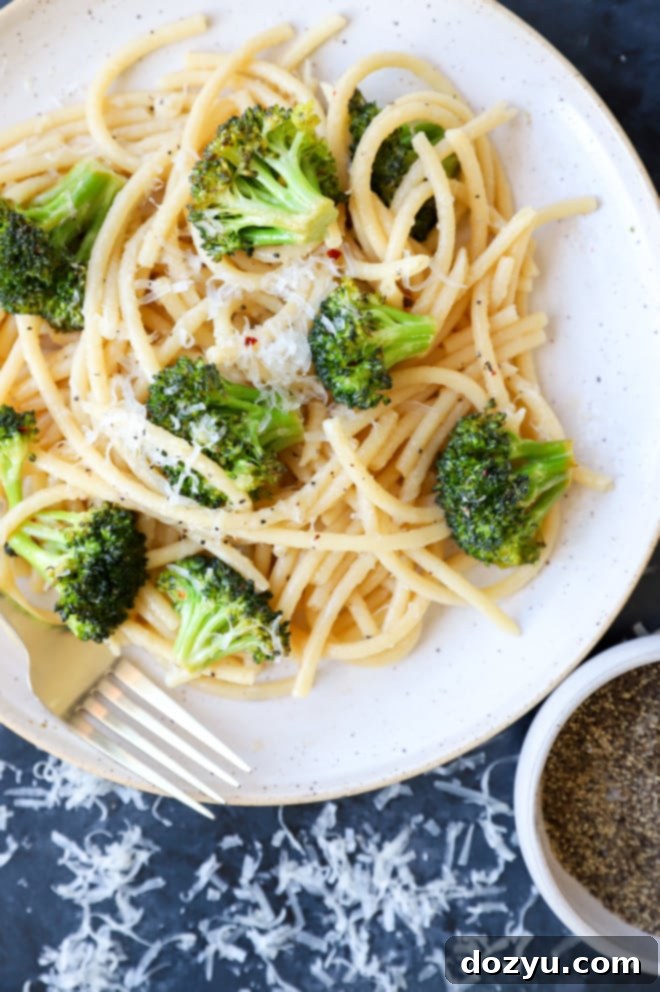
What to Serve with Bucatini Cacio e Pepe with Broccoli
This Bucatini Cacio e Pepe with Broccoli is a wonderfully versatile dish. Because it already includes a vegetable, it can easily stand alone as a satisfying vegetarian main course. However, it also pairs beautifully as a side dish with a variety of proteins or can be complemented by other simple additions to create a more elaborate meal. Here are some personal favorites:
- For a Hearty Main: Make it a more substantial meal by serving it alongside your favorite proteins. My classic Roasted Chicken with White Wine and Fresh Herbs offers a comforting and aromatic pairing. The rich flavors of the chicken complement the pasta without overpowering it.
- Add Some Steak: For meat lovers, slices of Balsamic Glazed Grilled Flank Steak served directly on top of the pasta turn this into an incredibly flavorful and visually appealing meaty main dish. The tang of the balsamic glaze provides a nice contrast to the creamy pasta.
- Seafood Delight: Simple and quick to prepare, Air Fryer Scallops are a fantastic light protein option. You can serve them directly over the pasta, perhaps skipping the chive butter from that recipe, or drizzling it on for an extra layer of flavor.
- Fresh Green Salad: If you want to keep the meal lighter, a crisp green salad with a simple vinaigrette is always a good choice. It adds freshness and a textural counterpoint to the rich pasta.
- Garlic Bread or Focaccia: Perfect for soaking up any leftover sauce, a warm slice of garlic bread or homemade focaccia is a classic Italian accompaniment that never disappoints.
- For Dessert: After such a flavorful main course, something light and bright is ideal. This easy Strawberry Shortcake in a Jar makes for a delightful and refreshing sweet ending!
How to Store and Reheat Leftovers
While Bucatini Cacio e Pepe is best fresh, storing and reheating leftovers is certainly possible. Here’s how to keep your pasta delicious for another meal:
- Storage: Once the pasta has cooled to room temperature, transfer any leftovers into an airtight container. Store it in the refrigerator for up to 5 days. Beyond this, the quality will start to decline.
- Reheating in the Microwave: For individual servings, place the pasta in a microwave-safe bowl. Add a splash (about 1-2 tablespoons) of water or milk to help rehydrate and revive the sauce. Microwave on medium power for 1 minute, then stir well. Continue heating in 30-second intervals, stirring in between, until the pasta is warmed through and the sauce has regained some of its creamy consistency. Be careful not to overheat, which can make the cheese seize.
- Reheating on the Stovetop: This method is generally preferred for larger portions, as it allows for more even reheating and better sauce revival. Transfer the leftover pasta to a saucepan or large skillet. Add a generous splash (2-4 tablespoons) of water or milk to the pan. Heat over medium-low heat, stirring frequently, until the pasta is hot and the sauce has become creamy again. You may need to add a bit more liquid if it still appears dry. The goal is to gently warm it through while coaxing the sauce back to life without burning the cheese.
The key to reheating Cacio e Pepe is to add a bit of liquid and gently warm it, coaxing the sauce back into a creamy state.
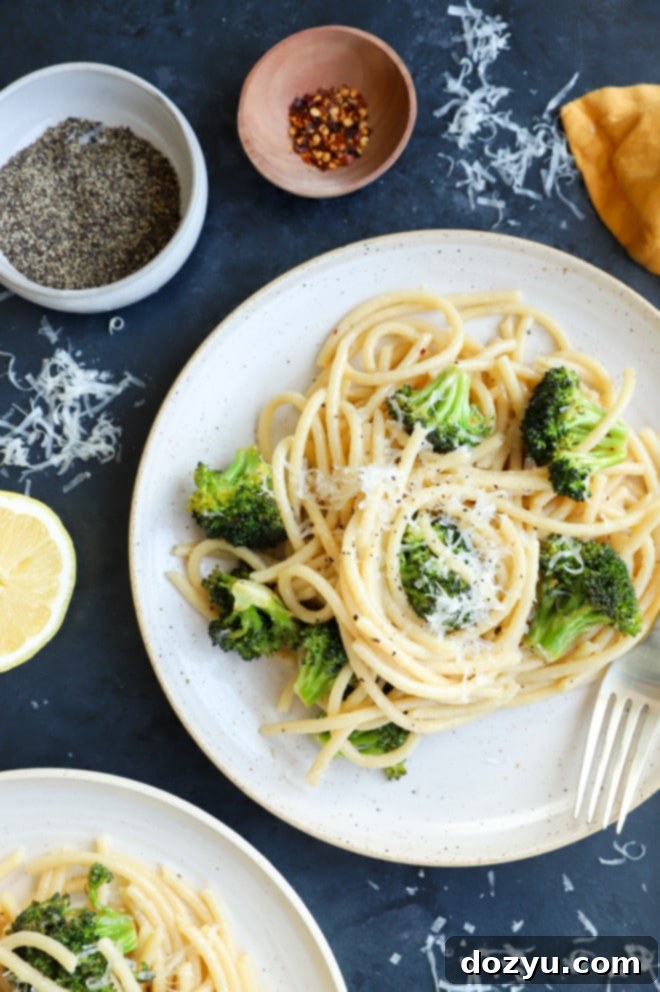
Finally, if you try this Bucatini Cacio e Pepe with Broccoli recipe, please don’t hesitate to leave a rating or a comment below! I genuinely love hearing from you and seeing your culinary creations. Your feedback helps me improve and inspires others. Feel free to ask any questions you might have about the recipe – I make sure to respond to every single comment.
And for those who love to share their kitchen adventures, be sure to tag me on Instagram if you make the recipe! It brings me so much joy to see these recipes come to life in your homes; scrolling through your photos truly means the world to me!
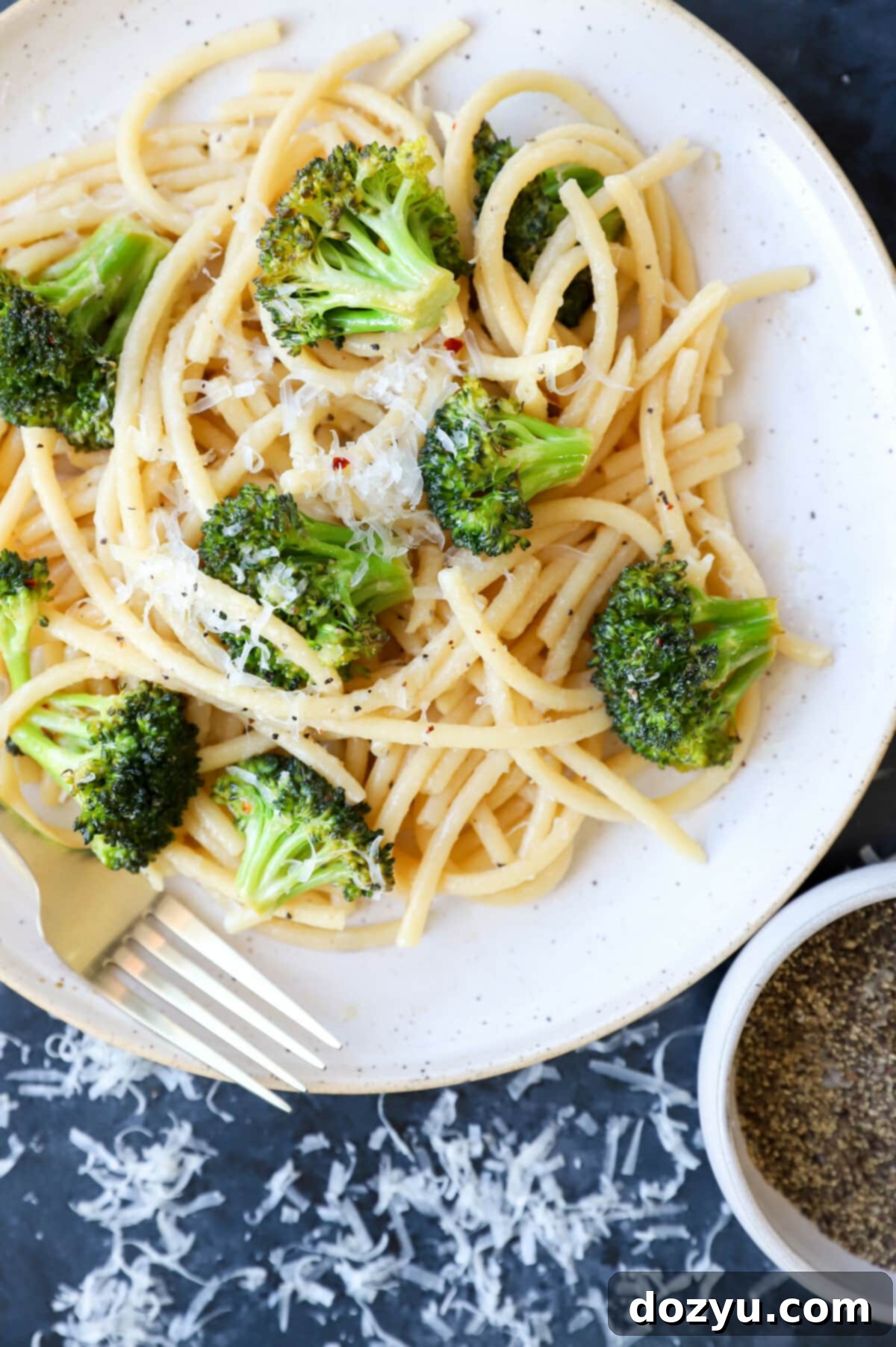
Bucatini Cacio e Pepe with Broccoli
Equipment
-
Shun Chef’s Knife
-
Organic Bamboo Cutting Board
-
9-Inch Tongs
-
Nonstick 12-Inch Skillet
Ingredients
- 1 bunch broccoli cut into florets approximately 1-2” in length
- 2 Tbsp olive oil
- 1 Tbsp fresh lemon juice
- 2 pinches red pepper flakes
- salt and pepper
- 8 oz uncooked bucatini you can also use spaghetti
- 2 Tbsp unsalted butter
- 1 tsp freshly-ground coarse black pepper
- 2 oz finely-grated Pecorino-Romano cheese or Parmesan
Instructions
-
Preheat the oven to 450˚F (230°C). Line a baking sheet with a silicone mat or parchment paper.
-
In a large bowl, combine the broccoli florets, olive oil, fresh lemon juice, and red pepper flakes. Season with salt and pepper, then toss thoroughly to coat. Spread the broccoli out in a single layer on the prepared baking sheet.
-
Roast the broccoli for 10 minutes, or until tender-crisp and slightly caramelized. Remove from the oven and set aside.
-
Bring a large pot of heavily salted water to a rolling boil over high heat. Once boiling, add the bucatini pasta and cook until it is just al dente (this is typically about 2 minutes shy of the package instructions). Reserve at least 1 to 1.5 cups of the starchy pasta water before draining.
-
While the pasta cooks, melt the unsalted butter in a large skillet over medium heat. Add the freshly ground coarse black pepper and cook for about 30 seconds, stirring constantly, to allow the pepper to bloom and release its aroma. Turn off the heat immediately and set the skillet aside.
-
Once the pasta is al dente, use tongs to transfer it directly to the skillet with the melted butter and bloomed pepper. Add 1/3 cup of the reserved pasta water to the pan and toss the pasta vigorously to combine. Begin to sprinkle a quarter of the finely grated Pecorino Romano (or Parmesan) cheese over the pasta. Toss continuously until the cheese has melted and formed a creamy sauce. Continue adding the cheese in small increments, waiting until each batch is fully melted and incorporated before adding the next, to create a smooth, glossy sauce.
-
If the sauce appears too thick or dry, add a few tablespoons of the reserved pasta water as needed, tossing continuously until the desired creamy consistency is achieved.
-
Gently fold in the roasted broccoli florets. Toss briefly to combine and warm the broccoli through. Serve the Bucatini Cacio e Pepe with Broccoli immediately, garnished with extra freshly ground pepper and a final sprinkle of freshly grated cheese. Enjoy right away!
Video
Nutrition
